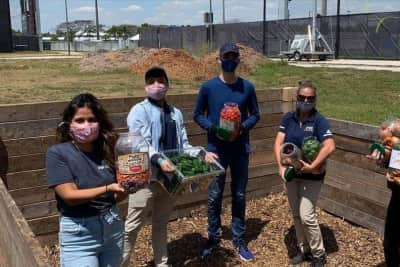The COVID-19 pandemic has had a significant negative impact on many local farming operations in South Florida. Consumers and producers are welcome to join our Facebook group FIU COVID-19 Local Food System Response for updates on local farms, available produce, contact information, relief programs, online resources and other forms of support.
Florida Tomato and Strawberry Supply Chain Study: Strategies for a Resilient Future
Florida is the United States' second-largest producer of tomatoes and strawberries, and it contributes almost 90 percent of the domestic winter tomato and strawberry productions. However, Florida tomato production has drastically declined over the years due to the market pressure from cheaper imports, weather uncertainties, and growing costs of inputs and labor.
With support from the Walmart Foundation, this project is exploring the Florida tomato and strawberry industries with a goal of promoting more environmentally sustainable and socially responsible production and supply.
Why FIU?
Our Agroecology Program is a nationally acclaimed comprehensive agriculture teaching, research and outreach program with a focus on veterans and socially disadvantaged farmers, migrant workers and minority students.
Findings

What does the future hold for the Florida tomato and strawberry industries? Can the Florida growers sustain their production given the emerging and projected changes in climate, regulations, and market forces? Are the regulations, markets, farm level conditions, and third-party certification systems ripe for promoting fair labor practices? Would the Florida tomato and strawberry supply chains remain resilient while balancing the interests of farmers, farm workers, consumers, and intermediaries throughout the supply chains?
These are some of the questions that the current project aims to address. The project will help us gain a better understanding of environmental sustainability and the impacts of climate and labor policy changes on production and eventually the entire supply chain system.
The project involves a series of primary survey of industry stakeholders, and advanced climate, plant growth, and market simulation models.
Stakeholders Symposium
FIU and Stronger Together US hosted a symposium on Dec. 4, 2020, with Florida produce industry stakeholders to co-develop a pathway for sustainable supply chains. These stakeholders' feedback will inform our final study recommendations for the sustainability of Florida's fresh produce supply chain.
Read the Symposium Proceedings and Study Highlights
Preliminary Findings
We present our preliminary findings for feedback from industry stakeholders to help us plan future research and design our blueprint for a more sustainable and efficient product certification system.
Farm-level economic, production, and sustainability issues
One of the specific objectives of our study is to improve our understanding of how growers are conducting different farm practices (pest, water and soil management) and overall operations in the context of changing climate, environmental and labor regulations, and market forces. We want to evaluate the consequences of recently enacted labor law and trade policies on labor migration in Florida. We conducted a series of face-to-face interviews with farmers, agricultural organizations and agencies and reviewed publicly available documents and reports. Based on our preliminary analysis, we find that:

Pre-cooling of strawberries at a growers' facility in Florida. Photo by Saoli Chanda
- Florida is the second largest in USA for producing both tomato and strawberry after California, owing to its seasonal advantage of being able to produce crops during the winter, and in turn, to receive premium rate (e.g., Florida tomato price of $0.48/lb compared to California price of $0.35/lb, and Florida strawberry price of $1.40/lb compared to California price of $1.06/lb).
- Profits from tomato have gradually declined over time due to the increasing costs of labor and declining market prices. “Farmers do not have any control on the selling price of produce. Price is mostly controlled by big retailers or buyers.” In response to these economic pressures, growers are both increasing their farm size and vertically integrating their operations to maximize net return. For example, some farms now undertake pre-planting nursery operations and post-harvest packing in addition to primary production. However, "large farms have more problems and issues than small farms. Small farms do not hire H2A, do not export, and do not transport their produce long distance."
- The major portion of the Florida tomato production consists of mature green round tomatoes (69%). The growers have not taken advantage of growing other categories of tomato, e.g. grapes, cherry, camperi, heirloom, etc. The main buyers of Florida Tomato are restaurants and fast food industries. The US demand for these other categories of tomatoes is primarily met by imports from Mexico.
- Overall Florida tomato yields have declined over the years while strawberry yields have increased.
- Florida strawberries have high demand in the Canadian market. Export of Florida strawberry to Canada has increased by 14% in last four years.
- A small portion of growers attempt organic production. Crop rotation with fallow is followed to control pests in the organic fields. Protected structure is also tried in a few instances for organic tomato production. Protected agriculture does produce taller plants and higher yields than field production, however, faces challenges against warm conditions, hurricane[1], and lack of proper pollination.[2] Better disease resistant varieties are needed for organic production in Florida. Interestingly, "not all buyers want organic. [For instance,] the demand for conventional strawberry is higher than organic strawberry."
- Florida climate is hot and humid, making growers rely on fumigants and pesticides during the crop production period. After the ban of methyl bromide, the costs of fumigants and pesticides have increased drastically. For tomato production, pesticides contribute (e.g., herbicide, insecticide, fumigants, and fungicide) 18% of the total production cost[3]. Farmers are seeking alternative measures to control pests and diseases and to provide nutrients. Some farmers use crab meals for controlling fungi and supplying calcium and magnesium.
- Protected structures are feasible for high value heirlooms, cluster, organic, or other specialized tomatoes. However, they are not popular among the large tomato growers as their target market is wholesale. Also, evaporative cooling technique of greenhouse doesn’t work in Florida during summer because of high relative humidity (90%). During winter, low light intensity with shorter day length results lower tomato productivity in greenhouse in Florida as compared to other regions in the USA.
- Florida produce industry is heavily dependent on foreign workers. Hiring of H2A immigrant workers has increased significantly in last ten years. Immigrant workers are expensive to hire as compared to domestic workers. Domestic labor wage ($8.50/hour) is almost $3/hour cheaper than the immigrant labor wage ($11.24/hour)[4], but domestic workers are in short supply. The pre-employment cost of the H2A immigrant workers can be as high as $2,000/person each year.[5] The rising labor cost is forcing many companies to invest into building machines to harvest strawberry mechanically.
[1] Gillespie, R., 2017, Hurricane Irma ravaged Florida crops, Putnam says. Orlando Sentinel, Issue: Sep 18, 2017, Retrieved from: https://www.orlandosentinel.com/politics/os-hurricane-irma-florida-agriculture-20170918-story.html
[2] Hochmuth, G. J., 2018, Production of Greenhouse Tomatoes—Florida Greenhouse Vegetable Production Handbook, Vol.3. Univ. Fla. Coop. Ext. HS788. Retrieved from: http://edis.ifas.ufl.edu/cv266
[3] VanSickle, J., S. Smith, and E. McAvoy, 2015. “Production budget for tomatoes in southwest Florida”. Florida Cooperative Extension Service. Retrieved from: http://ufdc.ufl.edu/IR00003786/00001
[4] US department of labor. 2019. Retrieved from: https://www.foreignlaborcert.doleta.gov/adverse.cfm
[5] Roka, F. M., Simnitt, S., and Farnsworth, D. 2017. Pre-employment costs associated with H-2A agricultural workers and the effects of the ‘60-minute rule’. International Food and Agribusiness Management Review, 20(3):335-346.
Contact Us
if you would like to take part in this research by providing helpful information, sharing your experience, or engaging in our upcoming webinars and workshops, please fill email Mahadev Bhat.

Team
Mahadev Bhat
Professor
305-348-1210
bhatm@fiu.edu
AHC5 375, CASE 157Carlos Parra
Professor
cmaparra@fiu.eduKateel G. Shetty
Research Assistant Professor
305-348-0178
shettyk@fiu.edu
VH 210Krishnaswamy Jayachandran
Distinguished University Professor and Co-Director of Agroecology Program
305-348-6553
jayachan@fiu.edu
AHC5 383Assefa M. Melesse
Professor
305-348-6518
melessea@fiu.edu
AHC5 390Ronald Mesia
Executive Director, Ryder Center for Supply Chain Management; Senior [...]
305-348-1663
rmesia@fiu.edu
RB 322
Contributors
- Stephany Alvarez, Senior Development Officer
- Saoli Chanda, Postdoctoral Associate
- Yared Bayissa, Temporary Postdoctoral Associate
- Ekta Shah, Temporary Research Associate
News
 Science & Technology
Science & TechnologyWater pollutant could be soil savior
Mar 28, 2024 Science & Technology
Science & TechnologyFlowers grown on polluted waterways can help clean up nutrient runoff
Feb 13, 2024 Science & Technology
Science & TechnologyOne-time Uber driver steers his way to success after FIU professor hails ride
Jun 27, 2023 Science & Technology
Science & TechnologyRare orchids could be saved by common fruits in Florida, research finds
Jan 19, 2023 Campus & Community
Campus & CommunityProfessor recognized for two decades of agriculture research
Jun 1, 2022 Campus & Community
Campus & CommunityFIU Hospitality marks Food Waste Prevention Week with activities and tips to end food waste
Apr 7, 2022
This research was made possible by generous support from the Walmart Foundation. The findings, conclusions, and recommendations presented in this report are those of researchers alone, and do not necessarily reflect the opinions of the Walmart Foundation.







